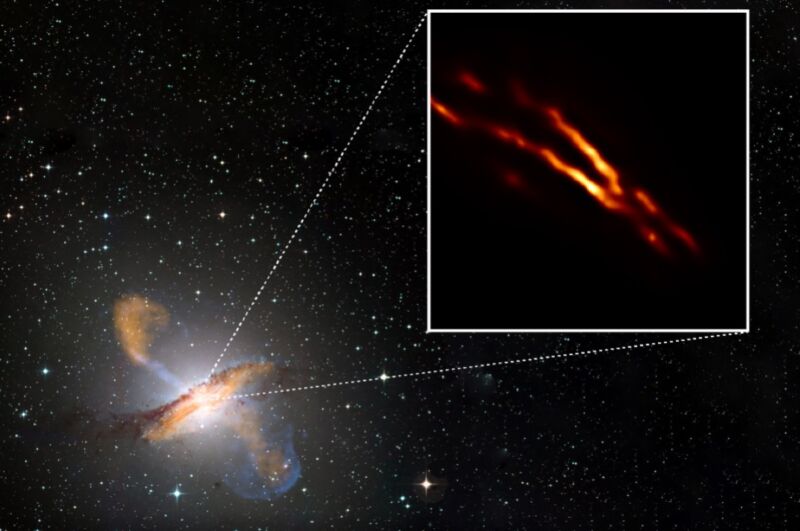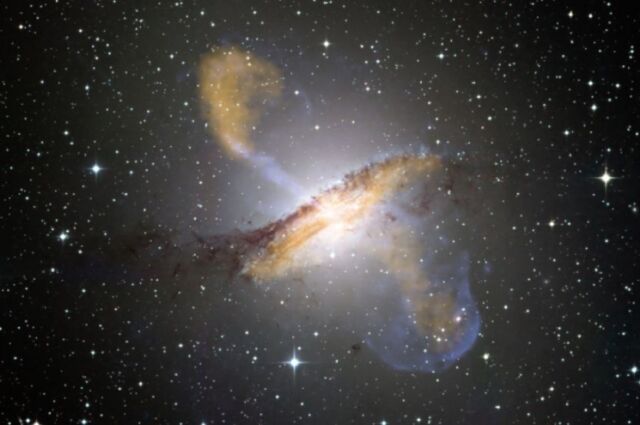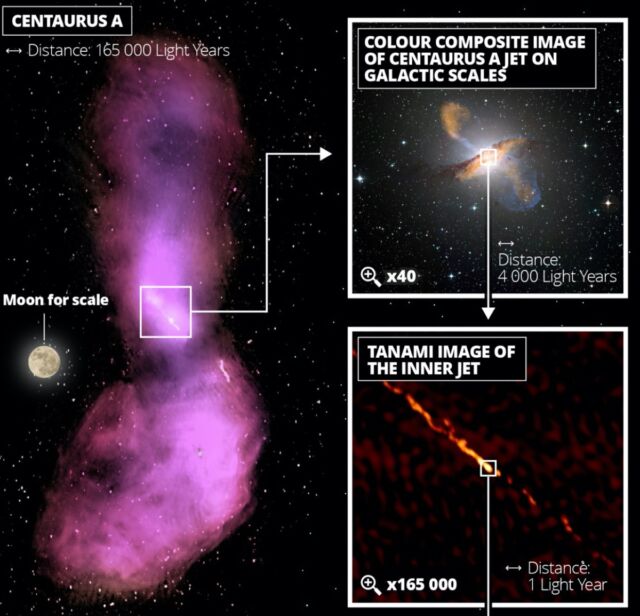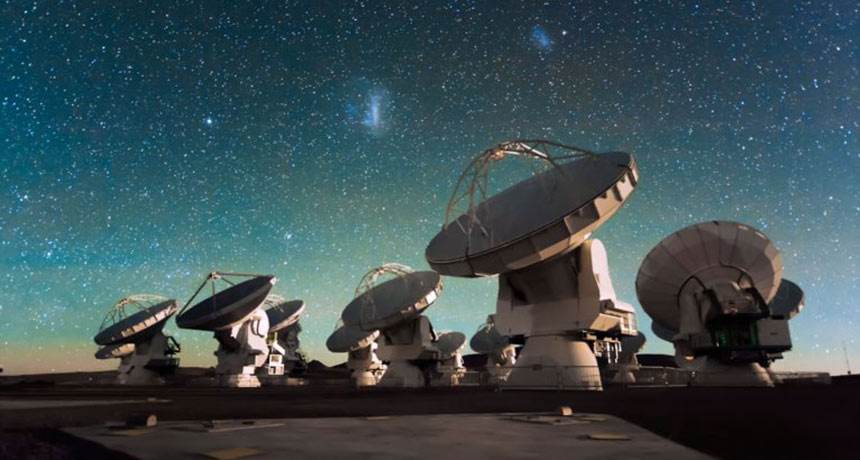
The Event Horizon Telescope (EHT) collaboration made headlines in 2019 by capturing the very first direct image of a black hole at the center of a galaxy. Now, the EHT is back with another exciting breakthrough: images of the "dark heart" of a radio galaxy known as Centaurus A. The images enable the EHT to pinpoint the location of the supermassive black hole at the galaxy's center, according to a new paper published in the journal Nature Astronomy. The images also capture the birth of a powerful jet emitting from the black hole. The jet's unusual characteristics could help astronomers answer a few nagging questions about how such jets are produced in the first place.
"This allows us for the first time to see and study an extragalactic radio jet on scales smaller than the distance light travels in one day," said co-author Michael Janssen, an astronomer at Max Planck Institute for Radio Astronomy in Bonn and Radboud University Nijmegen. "We see up close and personally how a monstrously gigantic jet launched by a supermassive black hole is being born."
Centaurus A (aka NGC 5128) is one of the largest and brightest objects in the night sky, making it especially popular with amateur stargazers, although it's only visible from the Southern Hemisphere and low northern latitudes. Located in the constellation Centaurus, the galaxy was discovered in 1826 by James Dunlop. In 1847, John Herschel noted its peculiar shape—it looks elliptical when viewed from Earth, with a lane of dust superimposed across it.

In 1949, astronomers identified Centaurus A as the first known source of radio waves outside the Milky Way galaxy. That's because the galaxy boasts an active galactic nucleus, which produces powerful jets that emit light in both X-ray and radio wavelengths that span distances far greater than the size of the galaxy itself. Centaurus A has been studied extensively ever since in the radio, optical, X-ray, and gamma-ray regimes.
As Ars' John Timmer reported back in 2019, the EHT isn't a telescope in the traditional sense. Instead, it's a collection of telescopes scattered around the globe. The EHT is created by interferometry, which uses light captured at different locations to build an image with a resolution similar to that of a telescope the size of the most distant locations. Interferometry has been used for facilities like ALMA (the Atacama Large Millimeter/submillimeter Array), where telescopes can be spread across 16 km of desert.
In theory, there's no upper limit on the size of the array, but to determine which photons originated simultaneously at the source, you need very precise location and timing information on each of the sites. And you still have to gather sufficient photons to see anything at all. So atomic clocks were installed at many of the locations, and exact GPS measurements were built up over time. For the EHT, the large collecting area of ALMA, combined with choosing a wavelength where supermassive black holes are very bright, ensured sufficient photons. The net result is a telescope that can do the equivalent of reading the year stamped on a coin in Los Angeles from New York City—assuming the coin was glowing at radio wavelengths.

The EHT announced the first direct image ever taken of a black hole at the center of an elliptical galaxy in 2019, located in the constellation of Virgo some 55 million light-years away: Messier 87 (M87). This image would have been impossible a mere generation ago, and it was made possible by technological breakthroughs, innovative new algorithms, and (of course) connecting several of the world's best radio observatories. The image confirmed that the object at the center of M87 is indeed a black hole. Small wonder that Science magazine named the image its Breakthrough of the Year.
What was still lacking was insight into the process behind the powerful twin jets produced by M87. Most matter near the edge of a black hole—attracted by the black hole's strong gravitational pull—falls in, but some particles can escape and get blown out via those massive jets at nearly light speed. But astronomers don't yet agree about how those jets get accelerated to such high speeds. Perhaps the mechanism is an accretion disk that produces a magnetic field, funneling some of that matter into a jet. Or maybe the rotational energy of the black hole as it spins is the culprit. Or the mechanism could be a combination of both.

Earlier this year, we reported on another groundbreaking result from the EHT collaboration: a new image of M87, this time showing how it looks in polarized light. The ability to measure that polarization for the first time—a signature of magnetic fields at the black hole's edge—yielded fresh insight into how black holes gobble up matter and emit powerful jets from their cores. The observations suggested that the magnetic fields at the black hole's edge are strong enough to push back on the hot gas and help it resist gravity's pull. So only the gas that slips through the magnetic field can spiral inward to the event horizon. Theoretical models that don't incorporate this feature of a strongly magnetized gas don't match the EHT's observations and thus can be ruled out.
The new images of Centaurus A place even more constraints around the various competing theories, further narrowing the possibilities. According to this latest EHT data, the radio emissions form massive lobes emanating outward from Centaurus A. But only the outer edges of the jets emit radiation, perhaps due to the jets colliding with galactic gas, thus heating the edge. "Now we are able to rule out theoretical jet models that are unable to reproduce this edge-brightening," said co-author Matthias Kadler of the University of Würzburg in Germany. "It's a striking feature that will help us better understand jets produced by black holes."
The new Centaurus A observations are also of interest because the black hole at its center is medium-sized: 55 million times the mass of our Sun. That falls smack in the middle between M87 (6.5 billion solar masses) and the mass of the black hole at the center of our own Milky Way galaxy (about 4 million solar masses). The jets emitted by Centaurus A's black hole look pretty much the same as the EHT's images of M87, just on a smaller scale. In other words, the Centaurus A black hole doesn't seem to behave differently from its bigger or smaller siblings, adding further credence to physicists' notion that these exotic objects can be defined just by their mass, charge, and spin.
"These data are from the same observing campaign that delivered the famous image of the black hole in M87," said co-author Heino Falcke of Radboud University. "The new results show that the EHT provides a treasure trove of data on the rich variety of black holes, and there is still more to come." One day, the collaboration hopes to use space-based telescopes to capture a direct image of the black hole at the center of Centaurus A, just like they did for M87.
DOI: Nature Astronomy, 2021. 10.1038/s41550-021-01417-w (About DOIs).



3175x175(CURRENT).thumb.jpg.b05acc060982b36f5891ba728e6d953c.jpg)

Recommended Comments
There are no comments to display.
Join the conversation
You can post now and register later. If you have an account, sign in now to post with your account.
Note: Your post will require moderator approval before it will be visible.